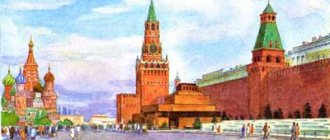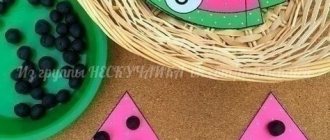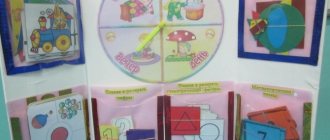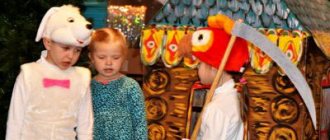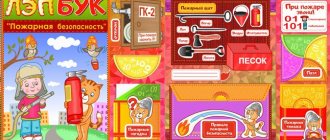Card index of games on speech development for children of senior preschool age with Lull rings
RINGS OF LULLIUS
Card index of games on speech development for children of senior preschool age
Game "Make sentences"
The game uses 2 circles (large and small), with 4 pictures on each circle.
Target.
Develop skills in writing sentences and coordinating words in a sentence. Develop the ability to compare, analyze, generalize, and concentrate. Activate visual functions (skills of fixation, tracking, visual correlation).
Progress of the game.
— The child is asked to spin a small circle of Lull rings. Consider the randomly placed pictures opposite each other and make sentences.
- You made a proposal. Now tell me, does this happen or doesn’t it happen?
— Independently correlate pictures on circles and make sentences.
Materials for the game.
1. Word-pictures of a small circle: fox, bag, tiger, gnome.
Word-pictures of a large circle: palm tree, scarf, Christmas tree, truck.
2. Word-pictures of a small circle: lion, wolf, fox, boa constrictor.
Word-pictures of a large circle: flowers, steamer, Kolobok, clown.
3. Word-pictures of a small circle: bear, snake, hedgehog, horse.
Word-pictures of a large circle: hedgehogs, bear cubs, squeezed, foal.
4. Word-pictures of a small circle: turtle, frog, cuckoo, mouse.
Word-pictures of a large circle: little mice, cuckoos, turtles, little frogs.
5. Word-pictures of a small circle: box, bumblebee, schoolboy, helmet.
Word-pictures of a large circle: seamstress, sewing machine, school, closet.
6. Word-pictures of a small circle: beetle, ball, cat, ball.
Large circle picture words: forest, house, whale, bee.
7. Word-pictures of a small circle: window, telephone, squirrel, mole.
Large circle picture words: leaf, pineapple, house, mushroom.
8. Word-pictures of a small circle: rocket, castle, hut, lemon.
Word-pictures of a large circle: robot, teapot, book, box.
9. Word-pictures of a small circle: woodpecker, flower, boy, Kolobok.
Large circle picture words: fly agaric, escalator, tree, house.
10. Word-pictures of a small circle: skirt, pipe, candy, book.
Large circle picture words: turnip, children, dog, girl.
Game “Match words starting with the same sound”
The game uses 2 circles (large and small). 4 pictures on each circle.
Target.
Learn to highlight the first sound in a word. Develop phonemic hearing, the ability to group, compare, analyze, generalize, and concentrate attention. Activate visual functions (skills of fixation, tracking, visual correlation).
Progress of the game.
— The child is asked to look at any picture, pronounce a word, “stretching out” the sounds. Highlight the first sound in a word.
- Look at other pictures, pronounce words, “stretching out” the sounds. Find a pair of four words for the first word.
- Connect the pictures yourself. Explain the choice.
Materials for the game.
1. Word-pictures of a small circle: duck, lamp, cat, stork.
Word-pictures of a large circle: watermelon, fishing rod, skis, pencil.
2. Word-pictures of a small circle: butterflies, pineapple, ball, hoop.
Word-pictures of a large circle: watermelon, beads, bear, cloud.
3. Word-pictures of a small circle: crocodile, mushroom, airplane, acorn.
Word-pictures of a large circle: accordion, boat, giraffe, table.
Game “Match the word with the sound pattern”
(determination of the place of a sound in a word: beginning, middle, end of the word;
determining the sequence of sounds in a word)
The game uses 2 circles (large and small). On the small circle there are diagrams of words, on the large circle there are pictures.
Target.
Learn to determine the place of a sound in a word (beginning, middle, end of a word); sequence of sounds in a word. Develop phonemic hearing, phonemic perception, the ability to group, compare, analyze, generalize, and concentrate. Activate visual functions (skills of fixation, tracking, visual correlation).
Progress of the game.
First option. Determining the place of a sound in a word.
— The child is asked to look at the pictures and pronounce them, “stretching out” the sounds. Determine where a certain sound (assigned by the teacher) is located in these words.
- Consider word patterns (small circle). Find where on the diagram it is shown that the sound lives at the beginning of the word, in the middle, at the end.
- Connect the picture and diagram yourself. Explain the choice.
Second option. Determining the sequence of sounds in a word.
— The child is asked to look at the pictures and pronounce them, “stretching out” the sounds. Determine the sequence of sounds in a word.
- Consider word patterns (small circle). Find which diagram matches the word.
- Connect the picture and diagram yourself. Explain the choice.
Materials for the game.
For the first option
1. Sound [С]. Words: bus, sun, cabbage, beads.
2. Sound [F]. Words: beetle, acorns, scissors, ice cream.
For the second option
1. Small circle: sound patterns of words.
Large circle picture words: beetle, wasp, mosquito, spider, bee, fly.
2. Small circle: sound patterns of words.
Large circle picture words: cloak, scarf, robe, rooster, ram, goose.
3. Small circle: sound patterns of words.
Large circle picture words: chicken, goat, cow, horse, cat, dog.
4. Small circle: sound patterns of words.
Large circle picture words: shorts, cockroach, rabbit, butterfly, fish, pomegranate.
5. Small circle: sound patterns of words.
Word-pictures of a large circle: beetle, wasp, mosquito, spider, bee, mu
Game “Match the word with the syllable pattern”
(determining the number of syllables, stress in a word)
The game uses 2 circles (large and small). On the small circle there are diagrams of words, on the large circle there are pictures.
Target.
Develop syllabic analysis skills. Develop the ability to highlight the emphasis in a word, group, compare, analyze, generalize, and concentrate attention. Activate visual functions (skills of fixation, tracking, visual correlation).
Progress of the game.
— The child is asked to look at the pictures, pronounce them, “slapping” the words syllable by syllable. Determine the number of syllables. Highlight the emphasis in words.
- Consider word patterns (small circle).
- Connect the picture and diagram yourself. Explain the choice.
Materials for the game.
1. Small circle: syllable patterns of words.
Large circle picture words: spring, pencil, frog, bear.
2. Small circle: syllable patterns of words.
Word-pictures of a large circle: car, globe, hat, chocolate.
3. Small circle: syllable patterns of words.
Word-pictures of a large circle: hedgehog, magazine, cloud, gooseberry.
4. Small circle: syllable patterns of words.
Word-pictures of a large circle: sled, dog, socks, apricots.
Game "Highlight the first sound"
(highlighting the first sound in a word)
The game uses 2 circles (large and small), 6 sectors each. On the small circle there are letters that can be used to write the first sound in a word, on the large circle there are pictures.
Target.
Develop the ability to identify the first sound in a word and relate it to the letter. Develop the ability to group, compare, analyze, generalize, and concentrate. Activate visual functions (skills of fixation, tracking, visual correlation).
Progress of the game.
— The child is asked to look at the pictures and pronounce them, highlighting the first sound.
- Look at the letters (small circle).
- Connect the picture and the letter yourself. Explain the choice.
Materials for the game.
1. Small circle: letters P, V, D, G, X, K.
Word-pictures of a large circle: peach, bicycle, melon, truck, bread, kefir.
2. Small circle: letters B, X, P, L, S, T.
Word-pictures of a large circle: doctor, artist, fireman, pig, tractor, swan.
3. Small circle: letters A, O, U, A, A, U.
Large circle picture words: watermelon, teacher, pineapple, donkey, apricot, duck.
4. Small circle: A, P, K, S, K, U.
Large circle picture words: boar, juice, pie, tick, pineapple, duck.
Game "Highlight the last sound"
(highlighting the last sound in a word)
The game uses 2 circles (large and small), 6 sectors each. On the small circle there are letters that can be used to write the last sound in a word, on the large circle there are pictures.
Target.
Develop the ability to identify the last sound in a word and correlate it with the letter. Develop the ability to group, compare, analyze, generalize, and concentrate. Activate visual functions (skills of fixation, tracking, visual correlation).
Progress of the game.
— The child is asked to look at the pictures and pronounce them, highlighting the last sound.
- Look at the letters (small circle).
- Connect the picture and the letter yourself. Explain the choice.
Materials for the game.
1. Small circle: letters A, O, I, A, O, I.
Word-pictures of a large circle: apple, socks, egg, caterpillar, tights, dragonfly.
2, Small circle: letters A, O, I, A, I, Y.
Word-pictures of a large circle: skirt, coat, trousers, shirt, gloves, jeans.
3. Small circle: letters A, O, Y, A, A, Y.
Large circle picture words: sausage, candy, pancakes, butter, milk, porridge.
\
Game “Highlight the first and last sound”
(highlighting the first and last sound in a word)
The game uses 2 circles (large and small), 6 sectors each. On the small circle there are letters that can be used to write the first or last sound in a word, on the large circle there are pictures.
Target.
To develop the ability to identify the first and last sound in a word and relate it to the letter. Develop the ability to group, compare, analyze, generalize, and concentrate. Activate visual functions (skills of fixation, tracking, visual correlation).
Progress of the game.
— The child is asked to look at the pictures and pronounce them, highlighting the first sound.
- Look at the letters (small circle).
- Connect the picture and the letter yourself. Explain the choice.
Materials for the game.
1. Small circle: letters A, N, P, R, K, T, V, T, G, K, D, K.
Word-pictures of a large circle: orange, cook, astronaut, grapes, racer, janitor.
2. Small circle: letters S, T, B, T, A, S, L, A, T, S, M, A.
Large circle picture words: plane, helicopter, bus, boat, trolleybus, car.
3. Small circle: letters P, K, S, T, F, A, I, K, M, N, T, T.
Word-pictures of a large circle: jacket, sweater, T-shirt, turkey, tangerine, motor ship.
4. Small circle: G, A, C, A, B, N, K, I, K, S, L, N.
Large circle picture words: pear, plum, banana, kiwi, coconut, lemon.
Summary of the TRIZ game methodology “Circles of Lull” with children of the middle group
Marina Nikitina
Summary of the TRIZ game methodology “Circles of Lull” with children of the middle group
means in children on the topic of wild animals.
Educational: Enrich children's knowledge about wild animals, activate their vocabulary. Fix the names of their cubs (singular and plural)
.
Develop the ability to compose complex sentences with the conjunction “to”
.
Developmental: Develop: communication skills; the ability to reason on a given topic; the ability to listen to the teacher and your comrades.
Educational: To cultivate interest and love for the animal world.
Material: model " Circles of Lull "
,pictures: depicting animals, their babies, table.
Preparation for activity: studying the lexical topic “Wild Animals”
.
1. Create interest
(Children stand in a circle )
-Today, guys, I again invite you to play with “magic circles ”
.
Do you want to play?
— To start the game, take your seats around the table .
(Children pass and sit around the table )
- Sit comfortably, press your back against the back of the chair, put your hands on your knees and be attentive.
— Guys, look at “magic circles ”
. Who do you see in the pictures?
- These are wild animals. (List animals)
- Right. There are pictures of wild animals on the circles Today we will talk about them.
And now we will play the first game, which is called “Who has who?”
.
-This game is familiar to us. Let's remember the rules.
— Sonya, remind the guys what to do in this game?
“We need to name the animal and pick up the baby.”
- You need to name the animal in the picture that falls under the arrow on the big circle , pick up and name the baby on the second circle , and name the baby in the plural (many) circle
.
-Another interesting game called “Finish the Sentence”
.
I'll start the sentence and you need to finish it using the word "to"
.
For example: a hedgehog needs thorns to protect itself from enemies.
The hare needs long ears to (hear well)
.
A fox needs a fluffy tail to (keep warm in winter, confuse its tracks)
.
A bear needs claws to (dig a den, fish, climb steep slopes, trees)
.
A tiger needs stripes to (protect itself from enemies, not scare away its prey)
. Etc.
Game exercise on TRIZ “Good - bad”
- Now, let’s think - the hare has big ears, what’s good and what’s bad about them?
— Large ears help the hare to hear well, and in winter they freeze.
— What benefits do spines bring to a hedgehog?
- He curls up into a ball
- Do the wolf have sharp teeth?
- Does the fox have a long tail?
(Discussion by children )
Analysis of activities, summing up.
“Now let’s all go to the carpet.” (Children go out onto the carpet and stand in a circle )
— Guys, what did we learn new about animals today?
— What animals did Lera remember?
— Which game did Vanya like best?
— Did you guys like it? Do you want to play more with “magic circles ”
? Next time they will definitely help us learn something more interesting!
- We played today, but it’s time to finish,
Analytical report on self-education “Developmental games with children using the M. Montessori method” MUNICIPAL BUDGET PRESCHOOL EDUCATIONAL INSTITUTION “KINDERGARTEN “ZVEZDOCHKA” P. SCHOOLNOE” ANALYTICAL REPORT ON THE IMPLEMENTATION OF THE PLAN.
Application for children of the 2nd junior group “Amazing circles” Amazing circles Kuznetsova Irina The artistic and aesthetic direction develops children’s thinking, creativity, and accuracy. Integrated lesson in the middle group (using elements of TRIZ game technology) “Helping the gnomes” Integration of educational areas: speech development, cognitive development, social and communicative development, physical development.
Summary of the game using the TRIZ technique “For Bear’s birthday” Goal: formation of coherent speech in children when meeting a bear; development of children's characteristics of empathy; ability to think using techniques.
Abstract of GCD for children of the middle group “Journey into the past of the city” with TRIZ elements Educational area: cognitive development. Goal: Formation of primary ideas about the small homeland. Program content: Educational.
Abstract of a GCD on ecology using a socio-game methodology “Migratory and wintering birds” Summary of a GCD on ecology using a socio-game methodology. Topic: “Migratory and wintering birds” Author: Kovalskaya Elena Sergeevna.
Abstract of an educational activity using OTSM-TRIZ technology for children of the middle group on the topic: “Composing a story based on a series of pictures.” SYNOPSIS OF ORGANIZATIONAL AND EDUCATIONAL ACTIVITIES USING OTSM-TRIZ TECHNOLOGY FOR CHILDREN OF THE MIDDLE GROUP TOPIC: “COMPOSITION.
Work experience “Using TRIZ technology “Circles of Lull” in speech therapy work” Rukhlya N. With. :Circles of Lull in the work of a speech therapist Description of work experience in using TRIZ technology “Circles of Lull” in speech therapy.
Educational and methodological manual “Rings of Lull” (TRIZ technology) “The questions began to spin, They connected with the signs. You choose a picture and give the answer quickly. " Dear colleagues! I present. Magic circles Lullia! Hello colleagues! Once, at one of the pedagogical councils, our methodologist told us about various types of didactic games, including.
Source
